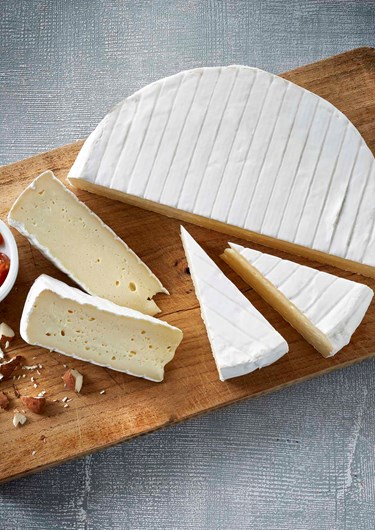
Brie
What is Brie?
Famed for its fluffy white rind and smooth interior, Brie is a genuine delicacy of opulent splendour. Made using milk from either cows or goats, the flavour is soothing, mellow and with a suggestion of nuttiness. Subtle tones of fresh mushrooms and sautéed butter cover its profile, extending into a creamy and smooth finish. A slice of tempered Brie has a soft texture, sometimes slightly runny.
Originally fromSeine-et-Marne in northern France, Brie is cherished for its impressionable character, and even graced the tables of royalty in the Middle Ages. Enhancing its surroundings like colour to a painting, Brie is versed as a complement like few other cheeses.
Often compared to Camembert, Brie is milder and with lighter tones of cream and butter, whereas Camembert holds deeper tones of mushrooms and herbs. Both are covered in iconic white mould rinds - completely edible and full of flavour.
Complement Brie with walnuts, honey and plum chutney, or melt it in the oven for a rich snack best shared with friends over a glass of wine. Enjoy it at room temperature by removing it from refrigeration at least half an hour before serving.
How Brie is made
Achieving the right consistency and full complement of flavours is a matter of letting the cheese tend to itself. Allowing the rind to smooth and ripen the interior is crucial to the development of taste and texture.
The process begins with pasteurised or raw milk from cows, and enzymes and rennet are added to the milk, helping it coagulate and curdle. A yeast culture is also added to foster the white mould. Once the curd has formed, it is cut and ladled into moulds, and excess whey is drained off. It is then carefully brined to prevent excess mould while also regulating acidity, as too much would impair the smooth flavour. The cheese then rests for a week, encouraging the rind to bloom and the nuances to enhance. Usually, Brie goes from firm to ripe in 4-5 weeks, with ripened variants displaying an almost runny consistency.
The use of raw or pasteurised milk varies depending on the type. Similarly, the use of either vegetarian or animal rennet is specific to each cheese. Organic Brie is normally pasteurised but checking the packaging or asking the cheesemonger is generally a good idea if you are unsure.
*Castello UK does not produce or sell Brie at the moment, let us know if you would like to try this Castello cheese by leaving us a message.
Other Variants
Whatever the recipe or occasion, if you are looking to replace Brie for something else, then soft-ripened cheeses with their cohesive and fluffy rinds give the best results.
Slightly firmer and with a stronger flavour, Camembert shares many of the same qualities found in Brie. With a taste of earthy mushrooms and a slight hint of caramelised butter, this white mould cheese could easily be mistaken for its counterpart.
A soft, delicate rind sprinkled like fine layers of powdered snow atop a creamy centre makes our Creamy White worthy of self-indulgence and a great substitute for brie. Smooth, buttery and deliciously well rounded, this white mould cheese boasts all the qualities of a creamy delight.

Explore Castello Brie
Find your favourite Castello Brie now
Curious about the world of cheese? Here's everything you need to know about how to store, serve and cut cheese!

Discover our cheeses
A world of surprising and indulgent sensations






